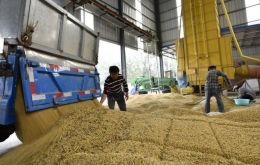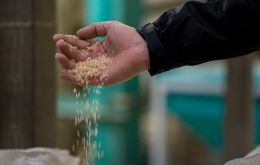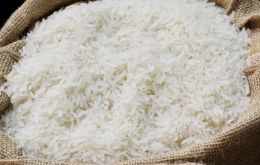MercoPress. South Atlantic News Agency
Tag: rice
-
Wednesday, March 23rd 2022 - 09:15 UTC
Brazilian two-month record breaking sales of soybeans and rice

Brazilian oilseeds and grain exports are booming. China's purchases of soybeans more than doubled in the first two months of the year, while husk rice overseas sales during February jumped 65% compared to a year ago.
-
Wednesday, January 12th 2022 - 09:25 UTC
Guyana's rice exports back on track thanks to Gov't help

Guyana's exports for the year 2021 of approximately 434,535 tons of rice, paddy, and its by-products meant US $ 201 million in revenues, according to Agriculture Minister Zulfikar Mustapha, after new export markets such as the British Virgin Islands (BVI) as well as Estonia and Slovenia were added to the list of buyers.
-
Thursday, November 12th 2020 - 09:26 UTC
Brazil forced to import rice to help keep domestic prices down given the expected smaller crop

Brazil’s rice production is expected to shrink and the challenge will be to limit exports in order to supply domestic demand and contain domestic prices.
-
Wednesday, October 7th 2020 - 09:02 UTC
Brazil purchases some 225,000 tons of rice from US, India and Guyana

Brazil has negotiated the purchase of 225,000 tons of rice from the United States, India, and Guyana, which are expected in the country during the second half of October and November.
-
Tuesday, September 22nd 2020 - 07:54 UTC
United States rice for Brazil: 30,000 tons according to USDA

The United States reported last week the sale of 30,000 tons of rice to Brazil. This follows on the decision from the Brazilian Chamber of Foreign Trade (Camex) to slash tariffs on rice to zero, helping to reduce the price of the grain for consumers.
-
Monday, September 14th 2020 - 11:19 UTC
China's impact on poor Brazilians: prices of staples skyrocket, black beans 30%, rice 20%

Black beans are up nearly 30%, beef about 40% – Brazilians are facing a skyrocketing rise in food prices, caused by record exports to China and strong domestic demand. This rebound, amid the economic and social crisis caused by the new coronavirus pandemic, has led the president, Jair Bolsonaro, to ask the owners of supermarkets to show “patriotism” and “keep their profit margin as low as possible”.
-
Friday, September 11th 2020 - 08:38 UTC
Brazil opens to tariff free rice, following price complaints from consumers

Brazil’s Executive Secretary of the Foreign Trade Board, “CAMEX,” voted on Wednesday to provide duty-free access for up to 400,000 tons of paddy and milled rice from all origins, effective this week through December 31, 2020. The measure was officially published in Brazil’s Official Gazette of the Federal Government and responds to growing consumer complaints about the retail price of rice, which with beans are staple for a majority of Brazilians.
-
Monday, November 12th 2018 - 07:11 UTC
This year will again be positive for global cereal production, anticipates FAO

The United Nations FAO has raised its forecast for global cereal production in 2018 to 2.601 million tons, primarily due to higher estimates for wheat production in Canada and China. Nonetheless, the new forecast remains 2.1 percent below the record level achieved in 2017.
-
Friday, April 8th 2016 - 06:58 UTC
Large inventories and sluggish demand for 2016/17 global cereal production predicts FAO

World cereal production in 2016 is set to amount to 2 521 million tons, just 0.2% off last year's large output and the third-highest global performance on record, according to FAO's first forecast for the new season, released on Thursday. Large inventory levels and relatively sluggish global demand mean that market conditions for staple food grains appear stable for at least another season, the agency's latest Cereal Supply and Demand Brief predicts.
-
Tuesday, November 11th 2014 - 21:03 UTC
Projected 2014 cereal production trimmed back despite record maize and wheat harvests

According to FAO's monthly Cereal Supply and Demand Brief release, the forecast for 2014 world cereal production by about one million tons. At 2.5 billion tons, the full-year production figure would be 3.7 million tons below 2013's record output.
